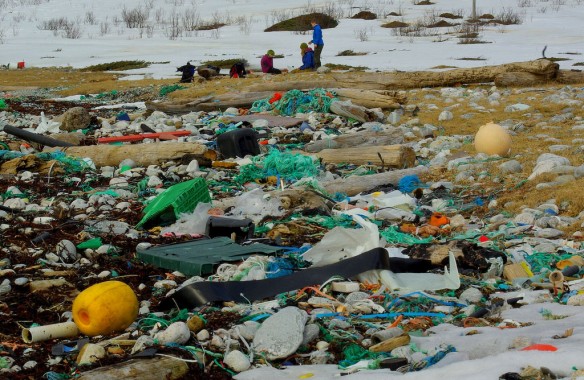Enshrouded in Plastic
Key concepts:
• seeking cost-effective solutions
• advocating for easier-to-initiate plans
• co-dependent problems & roadmapping
• urgency of the plastic problem
In January 2016 Dr. Erik van Sebille, oceanographer and lecturer at Imperial College London, with physics student Peter Sherman, conducted a study, published in the journal Environmental Research Letters on Jan. 19, 2016, that characterized how rivers and sewers transport floating plastic waste, bottles, caps, fibers, bags and ‘microbeads,’ which are then dispersed into the oceans. As an oceanographer, his earlier research had focused on currents. He saw how plastics were transported by those currents, and he began to follow the plastic – where it came from, where it ended up, and ultimately how to clean it up. There is substantial scientific research supporting the recommendations, discussed below. The Ocean Conservancy comments on this study, which grew out of physics student Peter Sherman’s participation in a ten week summer internship program sponsored by Imperial College, London, confirming the key role students can play.
Urgency of River, Coastline and Ocean Cleanup
The urgency of plastic killing ocean wildlife and entering the food chain calls for the three-pronged strategy shown in the diagram to avert the impending catastrophe to our global ecosystems. Elsewhere earthDECKS focuses on Ocean Garbage cleanup. There’s substantial information online about plastic production. This post focuses on coastline debris. 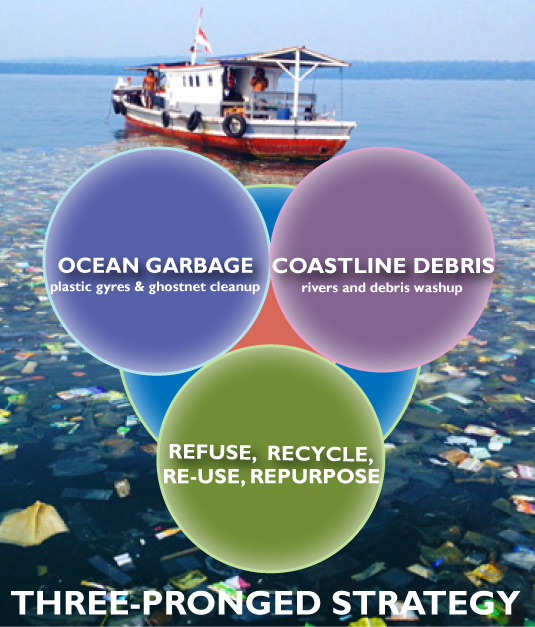
Most plastic lives longer than we do. The US National Park Service published estimated decomposition rates for plastic debris found on coasts, supported by this discussion on plastic pollution:
- Foamed plastic cups: 50 years
- Plastic beverage holder: 400 years
- Disposable diapers: 450 years
- Plastic bottle: 450 years
- Fishing line: 600 years.
To show the urgency of this crisis, we start with a photo introduction. For photo sources, see credits at the end of this post.
The United States would be foolish to assume this is solely a problem “somewhere else.” The Environmental Protection Agency (EPA) provides this photograph of a beach in Hawaii.
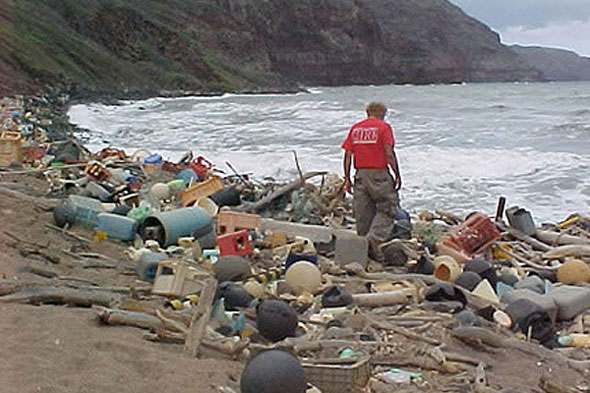
Below Smithsonian scientist Odile Madden sits amidst plastic recovered from Blue Fox Island in Alaska.
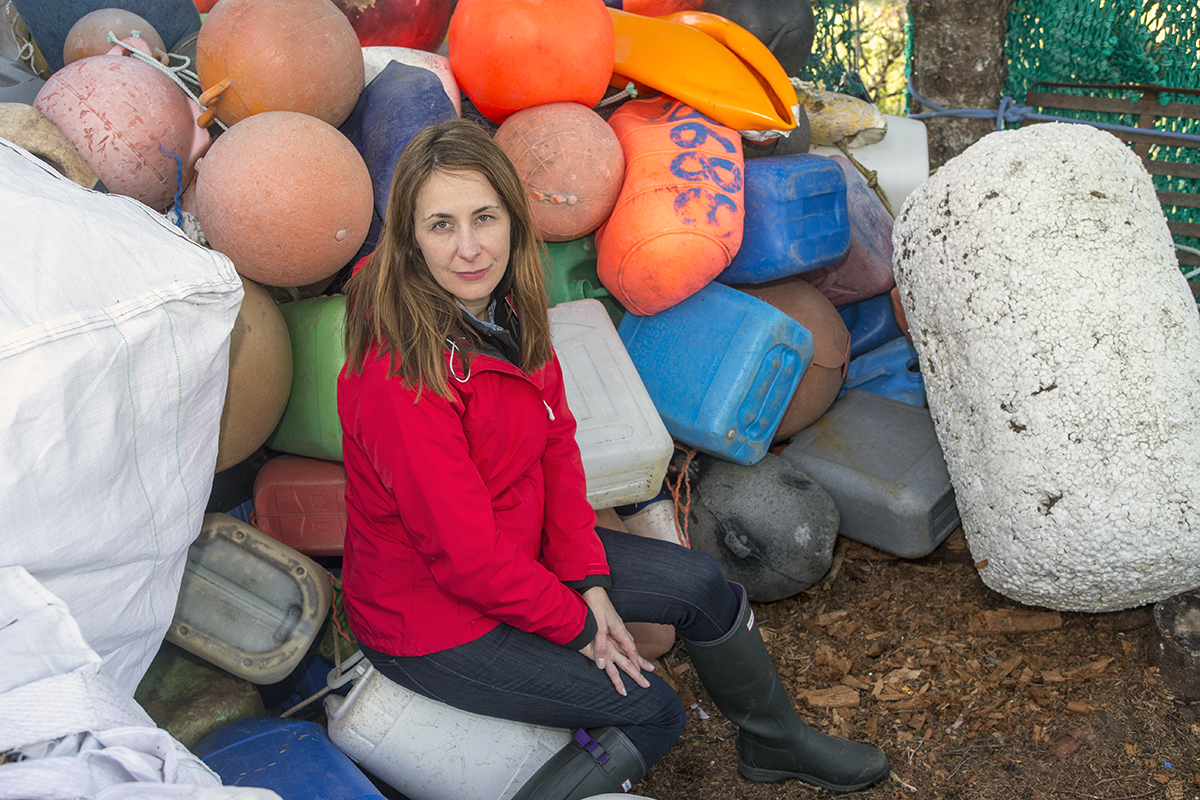
American river water is at risk, as shown by the garbage at the mouth of the Los Angeles River at Long Beach, California USA. Garbage is carried down rivers on all continents and washed onto all coasts.
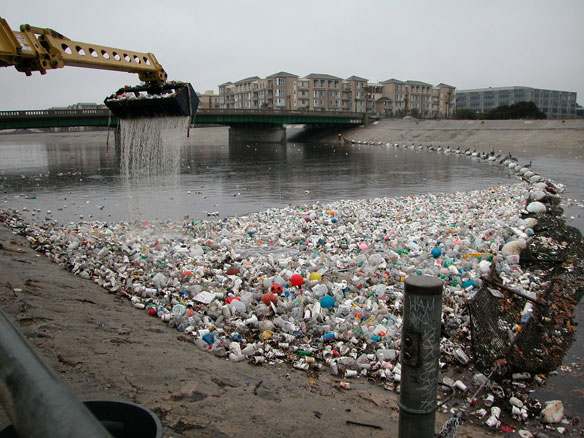 In New Delhi, India, two kids cool off from the heat in the only river they have to swim in. They are almost lost amidst the garbage in the Yamuna River, which has been described as a dying river.
In New Delhi, India, two kids cool off from the heat in the only river they have to swim in. They are almost lost amidst the garbage in the Yamuna River, which has been described as a dying river.
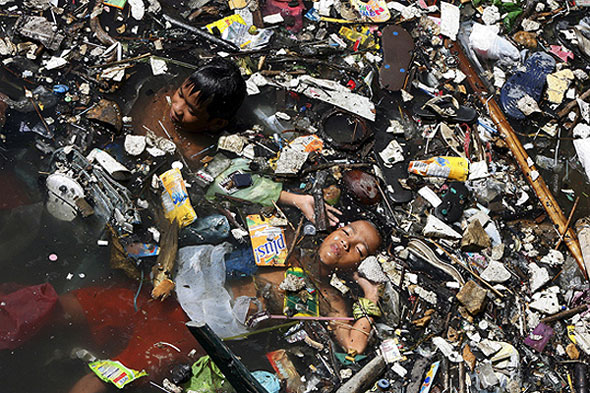
Four days after Sherman and Van Sebille’s scientific publication on January 19, 2016, on January 23, 2016, the UK Telegraph announced that the Yamuna River will be cleaned up with help from London, and published this photo: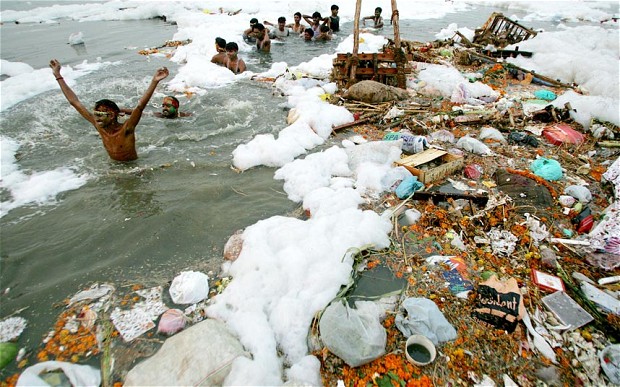
London Mayor Boris Johnson offered British help to clean up and revive the Yamuna at a meeting with Delhi’s chief minister Sheila Dikshit, who said she believes the Thames model could bring Delhi’s main waterway back to life.
India has spent almost £200 million on unsuccessful schemes to clean the river. Two thirds of Delhi’s 600 million gallons of sewage is dumped in the river every day.
Microplastics disrupt the phytoplankton, the microscopic plants that provide the basic food of various marine organisms and can enter the food chain where microscopic animals can ingest them and they are then eaten by larger animals progressing up the food chain. This, now classic, photo by Chris Jordan of a dead albatross with its stomach filled with plastic has become an icon for the threat.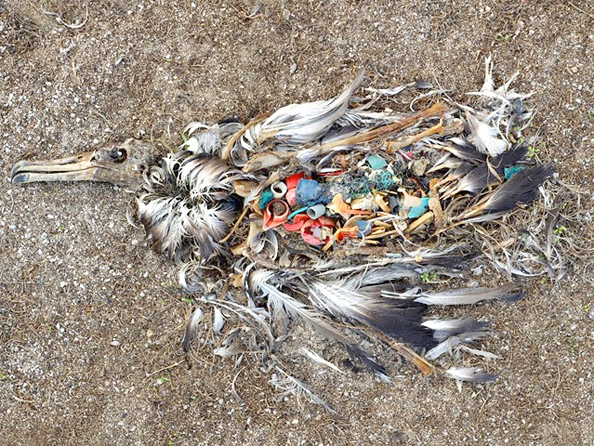
The Great Pacific garbage patch in the North Pacific open sea is surrounded by currents that transport and concentrate the microplastics in one area, which is estimated to be twice the size of the United Kingdom. The huge amount of plastic in the Great Pacific garbage patch has turned the area into almost a “dead zone” without life, in contrast to coastal areas. Plastics in the patch have already traveled a long distance, broken down into microplastic pieces that are hard to retrieve, and caused harm to sealife along the way.
A necropsy on dead sperm whales washed up on the shore of Germany earlier this year revealed varied plastics in their stomachs. Four of the 13 whales that washed up on the coast of Schleswig-Holstein in Germany had the plastic and other man-made items in their stomachs, said Schleswig-Holstein Wadden Sea National Park. Researchers found a fishing net, part of a car engine cover and a plastic bucket in the whales’ stomachs, according to the March 23 statement.
There are now five swirling ocean garbage patches, two in the Pacific, two in the Atlantic, and one in the Arctic.
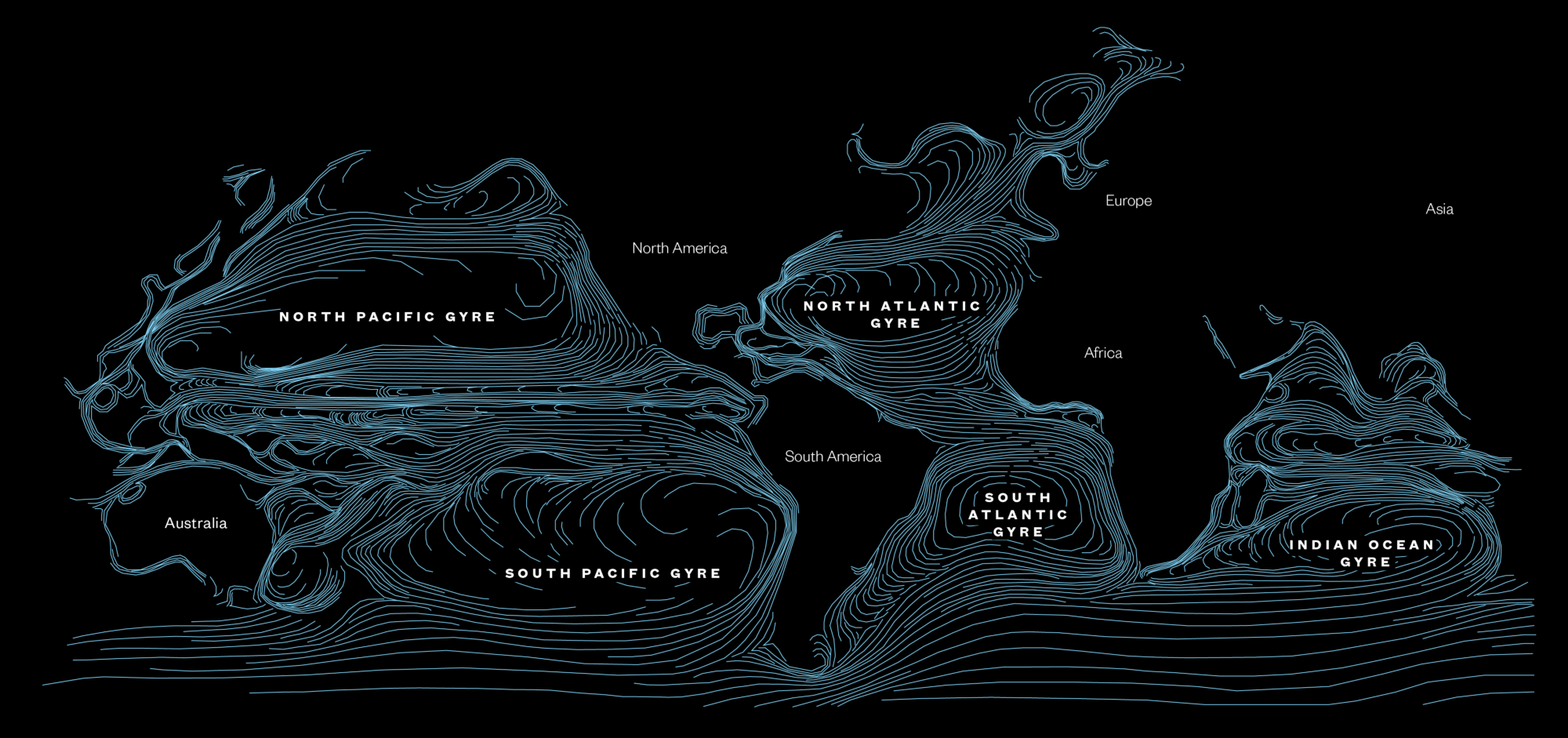
And the coastal garbage problem is not confined to coastlines on the Pacific Ocean. Below is a coastline in Norway, followed by a coastline in Morocco, showing that north and south, east and west, the litter is now everywhere.
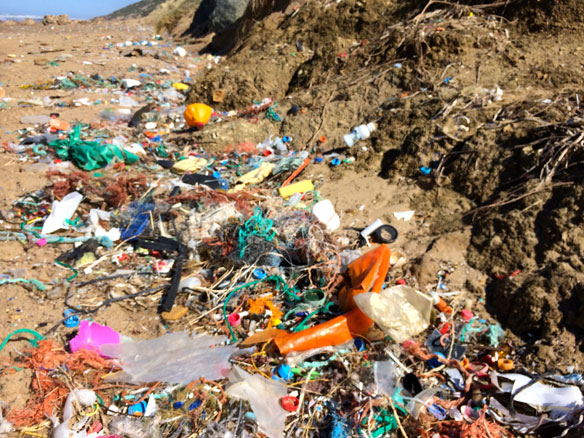 Until recently, to clean up plastic waste in the ocean there seemed to be only one option, a mammoth, multi-billion dollar high tech initiative where communities cleaning up their local beaches were not factored in as contributors. However, recent research suggests that one of the most cost-effective ways to tackle the ocean plastic waste challenge is by cleaning debris that washes up on coasts. What once appeared to be a problem requiring a costly, high tech capacity to scoop debris out of the Pacific Garbage Patch and the deep ocean, now there’s also a role for local crowdsourced coastal cleanup, initiated in affected local communities and expanding to have global impact.
Until recently, to clean up plastic waste in the ocean there seemed to be only one option, a mammoth, multi-billion dollar high tech initiative where communities cleaning up their local beaches were not factored in as contributors. However, recent research suggests that one of the most cost-effective ways to tackle the ocean plastic waste challenge is by cleaning debris that washes up on coasts. What once appeared to be a problem requiring a costly, high tech capacity to scoop debris out of the Pacific Garbage Patch and the deep ocean, now there’s also a role for local crowdsourced coastal cleanup, initiated in affected local communities and expanding to have global impact.
Although chemists are now working to develop more biodegradable plastic, traditional plastic waste can last thousands of years and can be ingested by marine life, leading to death, disruption of the ecosystems, and hindrance into the food chain.
Sebille and Sherman reported in their study that an even larger flow of plastics can be found off coasts. They propose “to remove plastics where they first enter the ocean around dense coastal economic and population centres where there is a lot of marine life.” added to remove plastic waste before it is ingested by sea creatures. Sherman and van Sebille are modeling the flow of ocean plastic to determine the best areas to target for collection and propose to deploy plastic collectors near the coasts as more cost-effective than concentrating on the patch itself.
The two researchers propose a 10-year plan estimate the amount of ocean plastic waste that can by deploying collectors near the coasts, focusing first on the Indonesian Islands and China. They estimate that 31 percent of microplastics can be cleared between 2015 and 2025 using this method, in contrast to only 1% if the Pacific Garbage Patch is the sole focus. In another analysis they estimated that targeting a coastal cleanup can reduce the harm by 46 percent in contrast to 14 percent if collectors concentrate in the patch. The difference in these estimates shows how hard accurate estimates are for such a problem, though it is certainly logical to focus on preserving life from litter at our coasts.
Both van Sebille and Ocean Voyages Institute argue that the focus must be on removing the garbage and that the kind of high tech solution proposed by Boyan Slat is not the way to achieve the most debris removal the fastest. We do not have time to wait to see which strategy delivers better results faster. We should simultaneously address our coastlines, the ocean garbage patches and the ghostnets.
Below is a partial list selected from van Sebille’s substantial peer-reviewed scientific research supporting this debris collection proposal, for which his earlier studies of ocean currents laid the foundation. The reason for including these citations is to show the substantial analysis behind their proposal.
Experts say without any improvement in waste management, the amount of plastic waste could increase tenfold by 2025. Increasing waste processing by up to 50 percent in the 20 worst offending countries could reportedly reduce ocean waste by 41 percent within 10 years. Improvements in waste processing in the 10 worst offending countries could reportedly reduce plastic waste dumped in the ocean each year by up to 6.4 tons by 2025.
The 10 biggest marine polluters (by millions of tons of plastic waste dumped in the ocean each year) are:
1. China 8.8 million tons
2. Indonesia 3.2
3. Philippines 1.9
4. Vietnam 1.8
5. Sri Lanka 1.6
6. Thailand 1.0
7. Egypt 1.0
8. Nigeria 0.9
9. Malaysia 0.9
10. Bangladesh 0.8
In February 2016 National Geographic published a study of the ocean plastic dumping problem, mapping the worst offenders.
 The United States is in the top twenty (number 20). Van Sebille and Sherman recommend an initial focus on China and Indonesia. Earlier this year China Insight looked at a case study of plastic bottles in Beijing, a city of over 20 million people, with a hot climate. The picture below graphically shows the problem:
The United States is in the top twenty (number 20). Van Sebille and Sherman recommend an initial focus on China and Indonesia. Earlier this year China Insight looked at a case study of plastic bottles in Beijing, a city of over 20 million people, with a hot climate. The picture below graphically shows the problem:
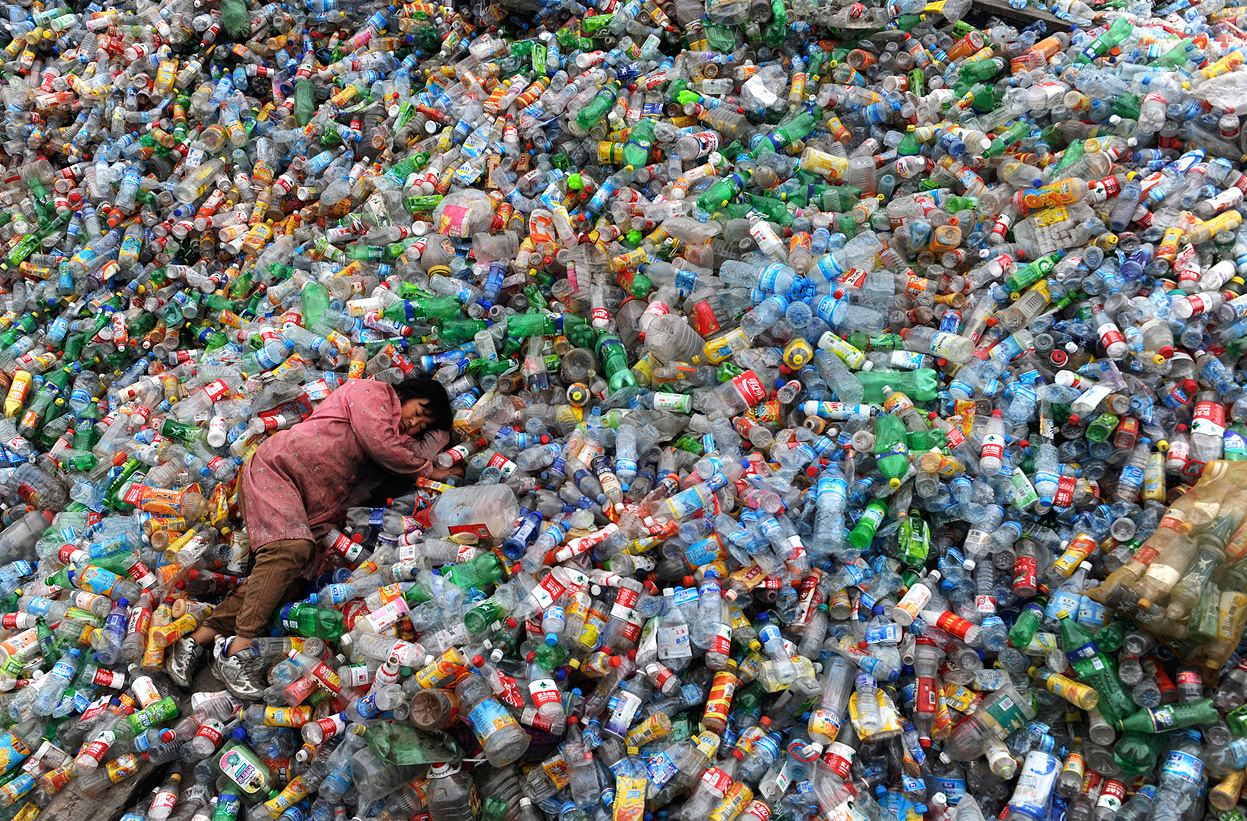
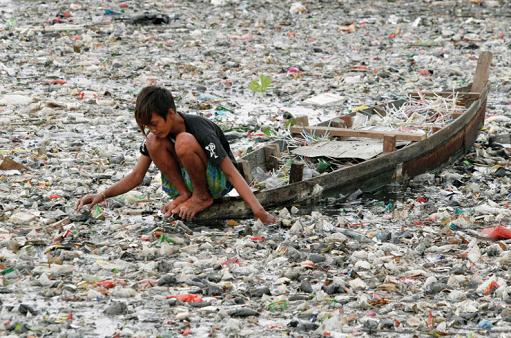
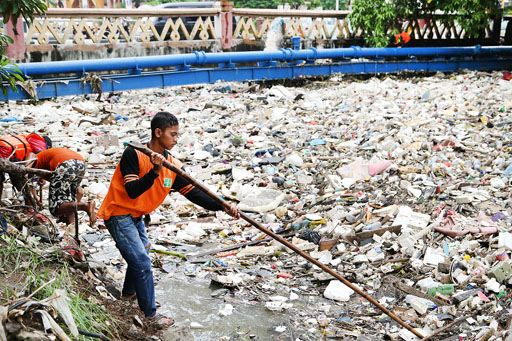
The Ellen MacArthur Foundation warned in a report published January 19, 2016 that plastic production has increased twentyfold over the last fifty years, and that there will be more plastic than fish in the ocean by 2050. Their report explains how applying “circular economy principles” to global plastic packaging flows, can “transform the plastics economy and drastically reduce negative externalities, such as leakage into oceans.”
Van Sebille articles in press (see Google Scholar for citation counts)
Ypma, Van Sebille, Kiss, and Spence (2016), J. Geophys. Res., in press.
The separation of the East Australian Current: a Lagrangian approach to potential vorticity and upstream control [ pdf @ publisher ]
Sherman and Van Sebille (2016), Environ. Res. Lett, in press. Modeling marine surface microplastic transport to assess optimal removal location
Grist, Josey, Jacobs, Marsh, Sinha, and Van Sebille (2016), Clim. Dyn., in press. Extreme air-sea interaction over the North Atlantic subpolar gyre during the winter of 2013-14 and its sub-surface legacy [ pdf @ publisher ]
Schuyler, Wilcox, Townsend, Wedemeyer-Strombel, Balazs, Van Sebille, and Hardesty (2016), Glob. Change Biol., in press. Risk analysis reveals global hotspots for marine debris ingestion by sea turtles [ pdf @ publisher ]
2015 Peer-reviewed articles
Van Sebille, Wilcox, Lebreton, Maximenko, Hardesty, Van Franeker, Eriksen, Siegel, Galgani, and Law (2015), Environ. Res. Lett., 10.
A Global Inventory of Small Floating Plastic Debris [ pdf @ publisher | data @ figshare]
Van Sebille, Waterman, Barthel, Lumpkin, Keating, Fogwill and Turney (2015), J. Geophys. Res., 120, 6769-6781. Pairwise surface drifter separation in the Western Pacific Sector of the Southern Ocean [ pdf @ publisher ]
Cetina-Heredia, Roughan, Van Sebille, Feng, and Coleman (2015), Glob. Change Biol., 21, 4377-4386. Strengthened currents override the effect of warming on lobster larval dispersal & survival [ pdf @ publisher ]
Wilcox, Van Sebille, and Hardesty (2015), Proc. Natl. Acad. Sci., 112, 11899-11904. Threat of plastic pollution to seabirds is global, pervasive, and increasing [ pdf @ publisher ]
Garzoli, Dong, Fine, Meinen, Perez, Schmid, Van Sebille, and Yao (2015), Deep Sea Res. I, 103, 125-136.The fate of the Deep Western Boundary Current in the South Atlantic [ pdf @ publisher ]
Teske, Sandoval-Castillo, Van Sebille, Waters, and Beheregaray (2015), Mar. Ecol. Prog. Ser., 532, 1-12. On-shelf larval retention limits population connectivity in a coastal broadcast spawner [ pdf @ publisher ]
Graham, De Boer, Van Sebille, Kohfeld, and Schlosser (2015), Deep Sea Res. I, 104, 9-25. Inferring source regions and supply mechanisms of iron in the Southern Ocean from satellite chlorophyll data [ pdf @ publisher ]
Peña-Izquierdo, Van Sebille, Pelegrí, Sprintall, Mason, Llanillo, and Machín (2015), J. Geophys. Res., 120, 3350-3372. Water mass pathways to the North Atlantic Oxygen Minimum Zones [ pdf @ publisher ]
Evans, Young, Nicol, Kolody, Allain, Bell, Brown, Ganachaud, Hobday, Hunt, Innes, Sen Gupta, Van Sebille, Kloser, Patterson, and Singh (2015), Mar. Policy, 59, 94-104. Optimising fisheries management in relation to tuna catches in the western central Pacific Ocean: A review of research priorities and opportunities [ pdf @ publisher ]
Qin, Sen Gupta, and Van Sebille (2015), J. Geophys. Res., 120, 3113-3128. Variability in the origins and pathways of Pacific Equatorial Undercurrent water [pdf @ publisher ]
Van Sebille, Scussolini, Durgadoo, Peeters, Biastoch, Weijer, Turney, Paris, and Zahn (2015), Nature Communications, 6, 6521. Ocean currents generate large footprints in marine palaeoclimate proxies [ pdf @ publisher ]
Sen Gupta, Brown, Jourdain, Van Sebille, Ganachaud, and Vergés (2015), Deep Sea Res. II, 113, 59-72. Episodic and non-uniform migration of thermal habitats in a warming ocean [ pdf @ publisher ]
Van Sebille (2015), Physics Today, 68, 60-61. The oceans’ accumulating plastic garbage [ pdf @ publisher ]
2014 Peer-reviewed articles
Van Sebille (2014), J. Exp. Mar. Biol. Ecol., 461, 317-322.
Adrift.org.au – a free, quick and easy tool to quantitatively study planktonic surface drift in the global ocean [ pdf @ publisher ]
Hellweger, Van Sebille, and Fredrick (2014), Science, 345, 1346-1349. Biogeographic patterns in ocean microbes emerge in a neutral agent-based model [ pdf @ publisher ]
Froyland, Stuart, and Van Sebille (2014), Chaos, 24, 033126. How well-connected is the surface of the global ocean? [ pdf @ publisher ]
Cetina-Heredia, Roughan, Van Sebille, and Coleman (2014), J. Geophys. Res., 119, 4351-4366. Long term trends in the East Australian Current separation latitude and eddy driven transport [ pdf @ publisher ]
Vergés, Steinberg, Hay, Poore, Campbell, Ballesteros, Heck, Booth, Coleman, Feary, Figueira, Langlois, Marzinelli, Mizerek, Mumby, Nakamura, Roughan, Van Sebille, Sen Gupta, Smale, Tomas, Wernberg, and Wilson (2014), Proc. Royal Soc. B, 281, 20140846. The tropicalisation of temperate marine ecosystems: climate-mediated changes in herbivory cause community phase shifts [ pdf @ publisher ]
Rosso, Hogg, Strutton, Kiss, Matear, Klocker, and Van Sebille (2014), Ocean Model., 80, 10-23. Vertical transport in the ocean due to sub-mesoscale structures: Impacts in the Kerguelen region [pdf @ publisher ]
Van Sebille, Sprintall, Schwarzkopf, Sen Gupta, Santoso, England, Biastoch, and Böning (2014), J. Geophys. Res., 119. Pacific-to-Indian Ocean connectivity: Tasman leakage, Indonesian Throughflow and the role of ENSO [ pdf @ publisher ]
Qin, Van Sebille, and Sen Gupta (2014), Ocean Model., 76, 20-30. Quantification of errors induced by temporal resolution on Lagrangian particles in an eddy-resolving model [ pdf @ publisher ]
Caley, Peeters, Biastoch, Rossignol, Van Sebille, Durgadoo, Malaize, Giraudeau, Arthur, and Zahn (2014), Geophys. Res. Lett., 41. Quantitative estimate of the palaeo-Agulhas leakage [ pdf @ publisher ]
Spence, Van Sebille, Saenko, and England (2014), J. Phys. Oceanogr., 44, 662-675. Using Eulerian and Lagrangian approaches to investigate wind-driven changes in the Southern Ocean abyssal circulation [ pdf @ publisher]
Den Toom, Dijkstra, Weijer, Hecht, Maltrud, and Van Sebille (2014), J. Phys. Oceanogr., 44, 464-481. Response of a strongly eddying global ocean to North Atlantic freshwater perturbations [ pdf @ publisher ]
Palmer, Turney, Hogg, Hilliam, Watson, Van Sebille, Cowie, Jones, and Petchey (2014), J. Archaeol. Sci., 42, 435-441. The discovery of New Zealand’s oldest shipwreck – possible evidence of further Dutch exploration of the South Pacific [ pdf @ publisher ]
Weijer and Van Sebille (2014), J. Clim., 27, 101-110. Impact of Agulhas Leakage on the Atlantic overturning circulation in the CCSM4 [ pdf @ publisher ]
2013 Peer-reviewed articles
Scussolini, Van Sebille, and Durgadoo (2013), Clim. Past, 9, 2631-2639.
Paleo Agulhas Rings enter the subtropical gyre during the penultimate deglaciation [ pdf @ publisher ]
Wilkins, Van Sebille, Rintoul, Lauro, and Cavicchioli (2013), Nature Communications, 4, 2457. Advection shapes Southern Ocean microbial assemblages independent of distance and environment effects [ pdf @ publisher ]
Rossi, Van Sebille, Sen Gupta, Garçon, and England (2013), Deep Sea Res I, 80, 37-46. Multi-decadal projections of the pathways and dilution of the Fukushima Cesium-137 radioactive plume [ pdf @ publisher ]
2012 Peer-reviewed articles
Van Sebille, England, and Froyland (2012), Environ. Res. Lett., 7, 044040.
Origin, dynamics and evolution of ocean garbage patches from observed surface drifters [ pdf @ publisher ]
Special Thanks for the article by Claire Le Guern Lytle
Unprecedented Plastic Pollution – When the Mermaids Cry: The Great Plastic Tide
and for the impressive work of CoastalCare.org gathering information and photos of this problem.
Photo Credits: Reuters photograph of fishermen in the Bay of Manila, Philippines, published in the Guardian
Mouth of the Los Angeles River, Long Beach, California. Photo source: © Bill McDonald, Algalita Foundation / Heal The Bay — Coastal Care
Plastic Debris in Hawaii. U.S. Environmental Protection Agency (EPA).
Yamuna River in New Delhi. Photo: Manan Vastsyayana — Coastal Care
Plastic pollution and marine debris, Morocco. Photo source: © SAF — Coastal Care
Littered beach in northern Norway. Photo source: © Bo Eide — Coastal Care
China Insight – case study of plastic bottles in Beijing
See the app @ earthDECKS.org
Saving Our Oceans from Plastic: articles by Zann Gill
- Adverse Health Effects of Plastic
- Aquaria – Informal Learning Network
- Beat the Microbead
- Bibliography: Plastic Roads
- Boyan Slat: Floater Technology for Ocean Cleanup
- Complex Systems Problems
- Cradle to Grave: Plastic Supply Chain
- Dame Ellen MacArthur: The Circular Economy
- Sylvia Earle: Learning for a Plastic World
- earthDECKS Limelights: Companies to Watch
- Flamingos Signal the Future We Face
- Floating Trash: More than 4x as bad as we thought
- Give the World a Helping Hand: 3D Prostheses
- Global Ocean Sensing
- Industry Response to the Plastic Challenge
- Nature’s Innovators: plastic consumers
- Ocean Debris Network
- Ocean Ingenuity
- Oceans – Measuring Planet Health
- Plastic Bank – The Exchange Economy
- Plastic – Climate Change Connection: Israel & UBQ
- PLASTIC: Complex Systems Problem
- Plastic: Drinking Water, Table Salt & Mother’s Milk
- Plastic Footprint – Carbon Footprint
- Plastic-Eating Enzyme
- Plastic Gyres and Social Justice
- Plastic Impact Calculator
- Plastic Pollution Coalition: Campaign vs Single Use Plastic
- Plastic & Public Health: Endocrine Disruptors
- PLASTIC: Overview of National Leadership
- Plastic Roads – Global Innovation Ecosystem
- Plastic – The Circular Economy
- The Plasticene
- Plastiki: adventure stories & a big message
- Raising Awareness of Plastic Hazards

